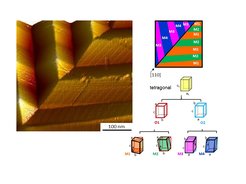Magnetic shape memory effects and magneto-structural coupling in Fe1+yTe
Recently, the iron chalcogenides received considerable attention in the condensed physics community which was mainly sparked by the discovery of superconductivity below Tc ~ 8.5 K in bulk FeSe. This superconducting transition temperature can be increased by the application of hydrostatic pressure, or by substituting about half of the Se atoms by Te. Interestingly, the binary end compound Fe1+yTe is not superconducting at all. Understanding this dichotomy may help shedding light onto the mechanism of superconductivity in the iron-based superconductors. However, it was soon realized that Fe1+yTe is an interesting material on its own right, exhibiting several unusual structural and magnetic phase transitions. As an example, a ferromagnetic state evolves through a so-called “type-0” transition at high pressures of around 2 GPa. In our recent paper, we report on two different types of magnetic shape memory effects, which are caused by a twinned microstructure and a strong magneto-structural coupling in the enigmatic compound Fe1+yTe.
Magnetic shape memory effects are extraordinary phenomena referring to a change in shape and/or size of a magnetic material upon applying a magnetic field. These effects emerge from either a persistent de-twinning of a twinned magnetically ordered material, in which the crystallographic axes are irreversibly reoriented by the applied magnetic field, or a magneto-elastic phase transition driven by an external magnetic field. These effects are usually observed in ferromagnetic materials with strong spin-lattice couplings, and the two types are rarely found in one and the same material. It should be noted that conventional shape memory nitinol alloys have found a tremendous number of applications in biomedical, technological, domestic, and textile industries. The magnetic analogues are increasingly gaining interest due to potential applications in magnetic actuators or sensors.
However, magnetic shape memory effects are not commonly observed in antiferromagnets and the exact mechanisms driving the effects are not well understood. Therefore, the identification of a new class of materials where these types of transformation in crystalline solids can be observed is an interesting result in itself. Our experimental results confirm that the two above-mentioned magnetic shape memory effects take place in the low-temperature antiferromagnetic phase of the material Fe1+yTe (y = 0.11, 0.12). By using scanning tunneling microscopy (STM) we were able to visualize the modulated and finely twinned microstructure resulting from a monoclinic crystallographic distortion of the tetragonal parent (high-temperature) structure. The antiferromagnetism of the monoclinic ground state allows for a magnetic-field induced reorientation of these twin variants by the motion of one type of twin boundaries, as evidenced by jumps in magnetization and magnetostriction measured along certain crystallographic directions in applied magnetic fields. In other words, the crystal can be driven from a complex hierarchical microstructure into a de-twinned, high-symmetry, quasi single-crystalline state through a field-induced metamagnetic transition. However, the antiferromagnetic ordering requires high magnetic fields to drive this transition.
At even higher magnetic fields, a second transition is observed, e.g. at ~52 T at 1.6 K for Fe1.12Te. This second transition is isotropic in nature, which calls for a different underlying mechanism. Yet, its irreversible behavior also indicates a memory effect. Accompanying density functional theory (DFT) calculation allowed us to estimate the strength of the magnetocrystalline anisotropy and the direction of the magnetic easy axis.
It is interesting to note that a magnetic shape memory effect was also reported for the famous high-Tc material, La2-xSrxCuO4. Since Fe1+yTe investigated here is structurally closely related to superconducting FeSe, one may wonder about commonalities between the cuprates and the Fe chalcogenides. In particular, there likely is strong electron-phonon coupling via the spin channel and mediated by spin-orbit coupling in these two classes of materials. Hence, the discovery of magnetic shape memory effects in Fe1+yTe is not only technologically relevant, but also of fundamental importance.
Steffen Wirth / SW

